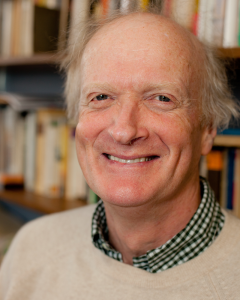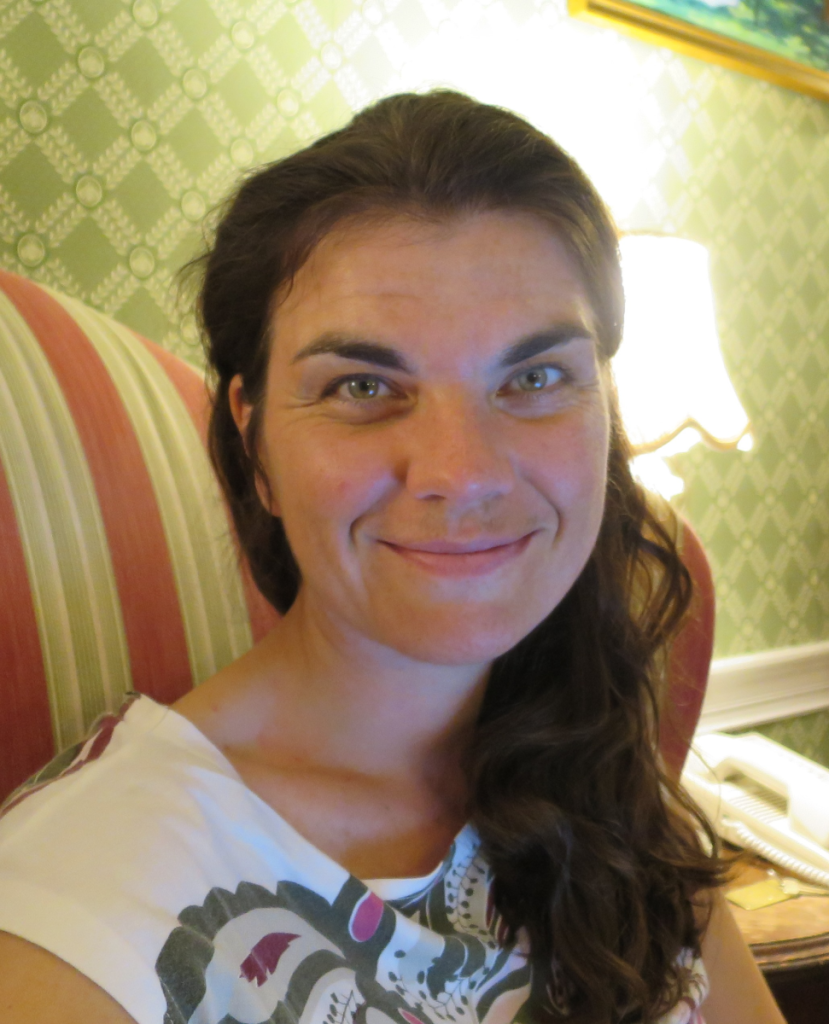
NER staff reader Simone Kraus speaks with author Mark Harman about self-translation and re-translation, Kafka, and his essay “Borges Translates Joyce Who Translates Himself,” which appears in NER 43.1.
Simone Kraus: I want to begin by asking you what inspired you to explore Borges’s ambivalent relationship with Joyce? Suzanne Jill Levine, in her essay “Notes to Borges’s Notes on Joyce,” writes that “Borges was always seeking himself in the writers he read, loved or loved to hate—a Narcissus perpetually leaning over the mirror of letters.” Would you agree?
Mark Harman: Why choose Borges and Joyce? Well, as with so much else in life, it was by happenstance. From a stay in Buenos Aires, where I was visiting my brother and his Irish-Argentinian wife, I got some insight into Argentinian culture. One can’t spend long in Buenos Aires without running into traces of Borges. I became particularly interested in his affinity with Irish writers, and especially that “love-hate” relationship of his with Joyce. As I read more of and about Borges, I sensed paradoxical parallels between the ways in which he and Joyce practiced the craft of translation. I grew further intrigued on noticing what Borges did—in his partial translation of the final “Penelope” chapter of Ulysses—with a gorse-covered headland on the outskirts of Dublin, not only because I happen to have grown up on that windswept hill, but also because a sense of place has long been a characteristic feature of Irish literature and lore.
SK: In your essay “Borges Translates Joyce Who Translates Himself” you address a topic which, I think, has been largely ignored, or rather neglected, by critics: self-translation. Prominent self-translators were/are Samuel Beckett, Nancy Huston, Milan Kundera, Jhumpa Lahiri, and Vladimir Nabokov. In your piece you, as a translator, look at the self-translator James Joyce. At the same time, you look at Joyce through the eyes of the translator Borges. It is a triangular approach. And within that triangle one can see more triangles. In his 1925 review of Ulysses, Borges writes: “Joyce expands and reforms the English language; his translator is obligated to take similar license.” You comment on this by saying “All the more so, one might add, when the writer and the translator are one and the same person. For, unlike most of us translators, who render the work of others, Joyce is free to do as he likes. Indeed, if any other translator rendered ‘ALP’ [“Anna Livia Plurabelle” from Finnegans Wake] as freely as does Joyce, he would be accused as Umberto Eco pointed out, of taking “intolerable license.” How much freedom do self-translators have?
MH: They enjoy unlimited freedom. Writers are free to change and adapt their work as they see fit, and the same principle surely applies to those who translate their own work. Joyce takes full advantage of that freedom in translating a short section of Finnegans Wake, a work that draws on words and phrases from over sixty languages. Although any adequate translation of the Wake would need to challenge conventional notions of translation, few translators would be willing to match Joyce’s audacity in relocating Anna Livia, a personification of the river Liffey, to Rome.
SK: In 1998, you published the essay “H. and K.: A Translator’s Story.” It is a very personal piece. Against the backdrop of Kafka’s world, you describe what it was like to grow up in Ireland in the 1950s and 1960s. And you discuss the complicated relationship with your father. Translating Kafka’s novel The Castle was a turning point in your life, because it gave you a sense of closure. In your essay you write that translating the novel “was like an axe for the frozen sea within me: in impersonating Kafka in English I drew on my own father-obsessed Irish upbringing and in the process distanced myself from it.” Is it Kafka who was responsible for getting you into translation?
MH: Well, Simone, I’d say yes and no. Yes, because reading Kafka had that “axe for the frozen sea” effect on me. Not immediately, though. When I first read The Castle as an undergraduate at University College Dublin I identified strongly with K., the main character. Like him, I was then a compulsive over-interpreter and had an almost Kafka-like obsession with my father, whom we called H., hence the title of the essay you mention. It was only years later, in graduate school in New Haven, that I was able to see K. in a different light. Subtle clues in the novel, which I had missed on a first reading, indicate that K. is completely mis-guided and therefore not a suitable role model for anyone. So, Kafka clearly was a formative influence, though not the initial impulse for taking up translation. For that I have to thank the Swiss writer Robert Walser, whom Kafka incidentally loved to read aloud. Reading Walser’s stories in German in the early eighties, I felt that anglophone readers needed to be exposed to more of his writing than was available in English at the time. So I translated a number of his short stories, which subsequently appeared in Robert Walser Rediscovered (UPNE).
But I continued to engage with Kafka as a reader, teacher, and scholar. It wasn’t, however, until the early nineties that by another fortunate happenstance a colleague, Cecile Zorach, alerted me to a piece in the New York Times which mentioned that Schocken Books was holding a contest for new translations of Kafka. I submitted a sample translation of a section of The Trial, and, although I was not selected that time, I was subsequently asked to submit a sample of The Castle, which I was then commissioned to translate. One of the things I most enjoyed while translating that novel was the opportunity to read drafts of the translation aloud chapter by chapter to a group of friends at the home of two colleagues, Lina Bernstein and David Kramer. Kafka himself loved to read his work aloud to family and friends in sessions which were often interrupted by laughter. I felt it was essential to do likewise since live “performances” of Kafka’s texts release qualities that are not so easily perceptible on a silent reading, especially his fine use of irony and dry sense of—often gallows—humor.
At the moment, I am putting finishing touches to a selection of Kafka’s stories which I have translated and annotated for a book under contract with Harvard University Press. Wearing both hats, as translator and commentator, has been something of a challenge, since the English versions I am commenting on happen to be ones that I myself have translated. Which brings up a variant on the old chicken and egg question: Which has priority, the translation on the page or the note in its margins? That question becomes significant whenever I touch on differences between English and German usage. Then I have to ask myself: is there any way I can modify the translation so that the need for such a note disappears? That in turn brings on, in addition to what Kafka famously called “commentators’ despair,” a bad case of “translator’s despair.”
SK: Regarding the translator’s role, has your perspective changed over the years? As I pointed out above, you once compared your task of translating The Castle to the act of impersonating Kafka in English. In another essay—”Digging the Pit of Babel: Retranslating Franz Kafka’s Castle“—you see yourself as Kafka’s medium. This is particularly interesting, because “medium” can mean many things, including the image of a person who is in contact with the spirits of the dead or who communicates between the dead and the living. A medium can also be the material or form used by an artist or writer. How do you define the job of a translator now?
MH: I don’t think my perspective on translation has changed. As you know, we translators play multiple roles at the same time, as impersonator, mime, medium, and ghostwriter. Those are rough analogies rather than precisely defined terms, since translation is a continuous balancing act. It is also, as a hoary dictate suggests, an “as if” craft: “Write as if the original author wrote in English” (or in whatever the target language happens to be). The notion of the translator as medium came to me as I was working on The Castle: having scarcely noticed that I had been up all night, I looked out the window and saw that it was dawn. That’s when I muttered to myself: “Was Kafka going mad when he wrote this or am I going mad translating it?”
SK: In an interview with World Literature Today, Michelle Woods—who wrote about you in her book Kafka Translated—reflects on the aspect of retranslation. She says that translators are, of course, very aware of their predecessors’ work, but from conversations with other translators she got the impression that they kept other translations out of mind while re-translating. What is your experience? Should a new translation be an improved version of earlier translations? Or is a new translation like a palimpsest?
MH: Like many translators, I get absorbed in my own process and in what I am trying to achieve. First, I identify recurring stylistic traits in a writer’s work, and then I try to craft a prose style that echoes the style of the original. Once I have a reasonably satisfactory draft, I sometimes find it useful, when stumped, to make spot checks to see what solutions other translators have found. At times I will adopt someone else’s solution, at other times the simple act of comparing different choices stimulates me to come up with a further solution.
Generally, I don’t like to comment on other versions of a book I have translated, since, as W. H. Auden once remarked in a review of new Thomas Mann translations, that is a task which “can only be congenial to the malicious.” I did so in the case of The Castle because, although I had been commissioned by Schocken Books, now a division of Penguin Random House, to translate that novel, one of the anonymous reviewers to whom the publishers sent the manuscript argued, or so I was told, that there was no need for a new version because the first translations by Edna and Willa Muir—the latter evidently did most of the work—were still more than adequate.
So, the manuscript sat abandoned in a drawer at the publishers while I sat frustrated at home in Lancaster, Pennsylvania. Not wanting a few years work to go down the drain, I wrote a piece for New Literary History outlining the case for issuing new translations of Kafka’s work, and of The Castle in particular. The argument revolved partly around the fact that Malcolm Pasley’s German critical edition of that novel was in itself sufficiently different from Max Brod’s to warrant a new translation. While praising the Muirs for their pioneering Kafka translations, I listed a number of criticisms of their version of The Castle that critics and scholars had been voicing for several decades. Although classic original works do not age, translations almost invariably do. That is true even of those rare translations that, like the Muirs’, achieve canonical status. I sent copies of the piece to editors on the upper floors of Random House. After a while, I received a call from the then editorial director at Schocken, who told me that my efforts “had not gone unnoticed” and that the book was being scheduled for publication.
SK: Thank you so much for your time, Mark.

Simone Kraus is an experienced translator living in Germany and the Czech Republic. She is the author of Prag in der amerikanischen Literatur: Cynthia Ozick und Philip Roth (Peter Lang, 2016), a book focusing on the literary representation of Prague in the works of Cynthia Ozick and Philip Roth. Simone’s work has also appeared in literary magazines, including literaturkritik.de and New England Review.